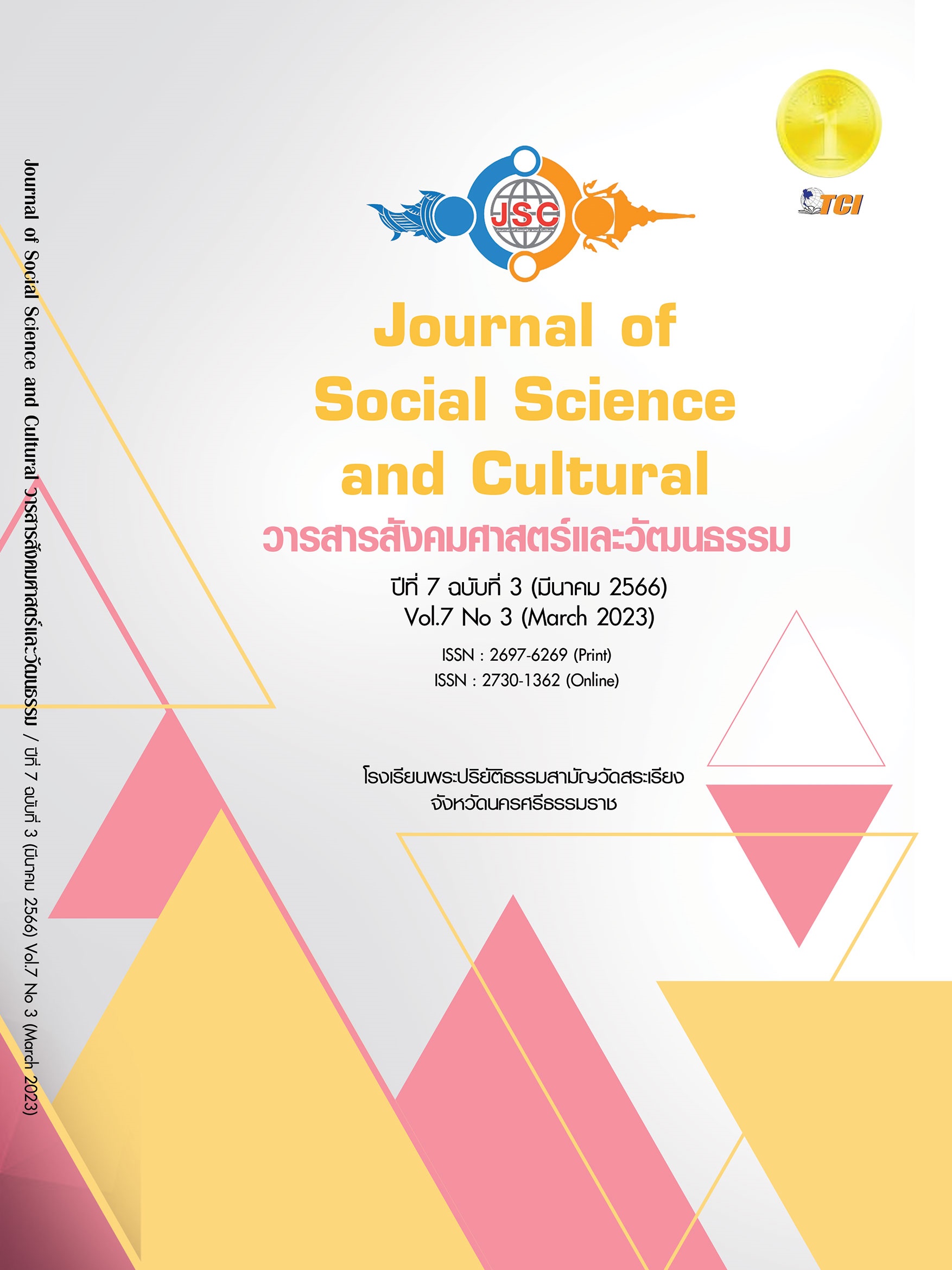การพัฒนาเกณฑ์การประเมินการจัดการการท่องเที่ยวโดยชุมชน สู่ความยั่งยืน
Main Article Content
บทคัดย่อ
บทความนี้นำเสนอเรื่อง การพัฒนาเกณฑ์การประเมินการจัดการการท่องเที่ยวโดยชุมชนสู่ความยั่งยืน การจัดการการท่องเที่ยวโดยชุมชน เป็นหนึ่งรูปแบบที่มีการขับเคลื่อนโดยชุมชน บริหารจัดการโดยชุมชน เพื่อชุมชนหลาย ๆ ชุมชนมีการจัดการที่ดี และอีกหลายชุมชนยังไม่มีทิศทางในการจัดการเพื่อให้เกิดการท่องเที่ยวในชุมชนที่ดี วัตถุประสงค์หลักของบทความนี้คือการพัฒนาเกณฑ์การประเมินการท่องเที่ยวโดยชุมชนเพื่อให้ชุมชนได้เล็งเห็นถึงองค์ประกอบการจัดการการท่องเที่ยวโดยชุมชน ที่มีคุณภาพและประสิทธิภาพ โดยเกณฑ์การประเมินการพัฒนานี้เกิดจากการทบทวนวรรณกรรม และงานวิจัยที่เกี่ยวข้องสามารถสร้างองค์ความรู้ใหม่ โดยใช้วิธีการดำเนินการทบทวนวรรณกรรมเชิงวิเคราะห์แนวคิดและทฤษฎีที่เกี่ยวกับการท่องเที่ยวโดยชุมชน, เกณฑ์การประเมินการท่องเที่ยวโดยชุมชน และการท่องเที่ยวอย่างยั่งยืน เพื่อนำแนวคิดและทฤษฎีดังกล่าวมาประยุกต์ใช้ในการสร้างเครื่องมือในการพัฒนาเกณฑ์การประเมินการจัดการการท่องเที่ยวโดยชุมชนสู่ความยั่งยืน ผลการศึกษาพบว่าการประเมินการท่องเที่ยวโดยชุมชน ประกอบไปด้วย 8 องค์ประกอบ ได้แก่ การบริหารจัดการภายในชุมชน ทรัพยากรธรรมชาติสิ่งแวดล้อมอย่างยั่งยืน มรดกและวัฒนธรรม แหล่งดึงดูดและแหล่งท่องเที่ยว เครือข่ายและชุมชนเข้มแข็ง ความปลอดภัย และการรับรองและบริการ เพื่อใช้ในการประเมินการบริหารจัดการการท่องเที่ยวโดยชุมชน ชุมชนสามารถนำเกณฑ์การประเมินมาประยุกต์และปรับใช้ในการประเมินการจัดการการท่องเที่ยวภายในชุมชน เพื่อให้การท่องเที่ยวโดยชุมชนมีความพร้อมของชุมชน ความพร้อมทางด้านศักยภาพของพื้นที่ รวมไปถึงความรู้ความเข้าใจในมาตรฐานเกณฑ์การประเมิน และการบูรณาการ และให้เกิดมาตรฐานการรองรับจากหน่วยงานรวมทั้งสามารถขับเคลื่อนการท่องเที่ยวภายในชุมชนเกิดความยั่งยืนสืบไป
Article Details
References
คณะกรรมการพัฒนาเศรษฐกิจและสังคมแห่งชาติ. (2558). การจัดทำแผนพัฒนาเศรษฐกิจและสังคมแห่งชาติ ฉบับที่ 12 (พศ.2560-2564). กรุงเทพมหานคร: สำนักงานคณะกรรมการพัฒนาเศรษฐกิจและสังคมแห่งชาติ.
พจนา สวนศรี. (2546). คู่มือการจัดการท่องเที่ยวโดยชุมชน. กรุงเทพมหานคร: โครงการท่องเที่ยวเพื่อชีวิตและธรรมชาติ.
พจนา สวนศรี และคณะ. (2556). คู่มือมาตรฐานการท่องเที่ยวโดยชุมชน. เชียงใหม่: โครงการท่องเที่ยวเพื่อชีวิตและธรรมชาติ.
พิมพ์ระวี โรจน์รุ่งสัตย์. (2553). การท่องเที่ยวชุมชน. กรุงเทพมหานคร: โอเดียนสโตร์.
ฟองจันทร์ หลวงจันทร์ดวง และคณะ. (2561). การพัฒนาตัวชี้วัดการท่องเที่ยวชุมชนเชิงสร้างสรรค์อย่างยั่งยืน. Electronic Journal of Open and Distance Innovative Learning (e-JODIL), 8(1), 79-104.
สถาบันการท่องเที่ยวโดยชุมชน. (2559). การท่องเที่ยวโดยชุมชน. เรียกใช้เมื่อ 24 พฤษภาคม 2565 จาก http:// www.cbt-i.or.th/index.php
สำนักพัฒนาแหล่งท่องเที่ยว. (2550). คู่มือเครือข่ายการท่องเที่ยวโดยชุมชน. กรุงเทพมหานคร: กระทรวงการท่องเที่ยวและกีฬา.
องค์การบริหารการพัฒนาพื้นที่พิเศษเพื่อการท่องเที่ยวอย่างยั่งยืน. (2556). การท่องเที่ยวเชิงสร้างสรรค์. เรียกใช้เมื่อ 24 พฤษภาคม 2565 จาก htpp://www.dasta.or.th/th/ sustain/sustainablecreative-tourism
องค์การบริหารการพัฒนาพื้นที่พิเศษเพื่อการท่องเที่ยวอย่างยั่งยืน. (2559). การท่องเที่ยวเชิงสร้างสรรค์. เรียกใช้เมื่อ 24 พฤษภาคม 2565 จาก https://pattani.mots.go.th/ download_ebook.php?eid=5
Blackstock, K. (2005). A critical look at community based tourism. Community Development Journal, 40(1), 39-49.
Boyd, H., & Charles, A. (2006). Creating community-based indicators to monitor sustainability of local fisheries. Ocean & Coastal Management, 49(5-6), 237-258.
Dangi, T. B., & Jamal, T. (2016). An integrated approach to “sustainable community-based tourism”. Sustainability, 8(5), 475.
George, B. P., Nedelea, A., & Antony, M. (2007). The business of community based tourism: a multi-stakeholder approach. Tourism issues, 3(1), 1-19.
Gutierrez, E. L. M. (2019). Participation in tourism: Cases on Community-Based Tourism (CBT) in the Philippines. Ritsumeikan Journal of Asia Pacific Studies, 37(1), 23-36.
Ibrahim, H. (2012). Ecological Indicators for Landscape Assessment-Moving Forward with Sustainability Initiatives for Qatar. J Ecosyst Ecogr, 2(5), 1-7.
Jannah, E., et al. (2018). Community-Based Tourism Development at Gajah Mungkur Wonogiri Tourist Attraction. IOP Conference Series: Earth and Environmental Science, 145(1):012017.
Karim, A. (2020). The Role of Village Tourism in Improving the Community's Economy During the Covid-19 Period in Enrekang District. Retrieved May 24, 2022, from HTTPS:// WWW. ACADEMIA. EDU, 43716400
Kokkhangplu, A., & Kaewnuch, K. (2017). Guideline to Enhance Performance Efficiency on Tourism Destination in Khanom Community, Nakhon Si Thammarat Province. Dusit Thani Journal, 11(speacial), 139.
Kontogeorgopoulos, N., et al. (2014). Success factors in community-based tourism in Thailand: The role of luck, external support, and local leadership. Tourism Planning & Development, 11(1), 106-124.
Kotwal, P., et al. D. (2008). Ecological indicators: Imperative to sustainable forest management. Ecological Indicators, 8(1), 104-107.
Látková, P., & Vogt, C. A. (2011). Residents’ Attitudes toward Existing and Future Tourism Development in Rural Communities. Journal of Travel Research, 51(1), 50-67.
Ledwith, M. (2020). Community development :A critical approach. Policy Press, 12(3), 1-2.
Lee, H., et al. (2019). Tourists’ happiness: are there smart tourism technology effects. Asia Pacific Journal of Tourism Research, 23(5), 486-501.
Lendelvo, S., et al. (2020). A perfect storm? The impact of COVID-19 on community-based conservation in Namibia. Namibian Journal of the Environment, 4(1), 1-15.
López-Guzmán, T., et al. (2011). Community-based tourism in developing countries: A case study. Tourismos, 6(1), 69-84.
Ma, Heywood, & MacIntyre. (2020). Travel health risk perceptions of Chinese international students in Australia–Implications for COVID-19. Infection, disease & health, 25(3), 197-204.
Manyara, G., & Jones, E. (2007). Community-based tourism enterprises development in Kenya: An exploration of their potential as avenues of poverty reduction. Journal of Sustainable Tourism, 15(6), 628-644.
Mayaka, M., et al. (2018). Participation as motif in community-based tourism: a practice perspective. Journal of Sustainable Tourism, 26(3), 416-432.
Mtapuri, O., & Giampiccoli, A. (2016). Towards a comprehensive model of community-based tourism development. South African Geographical Journal, 98(1), 154-168.
Novelli, M., Klatte, N., & Dolezal, C. (2017). The ASEAN community-based tourism standards: Looking beyond certification. Tourism Planning & Development, 14(2), 260-281.
Nunkoo, R. (2015). Tourism development and trust in local government. Tourism Management, 46(1), 623-634.
Okazaki, E. (2008). A community-based tourism model: Its conception and use. Journal of Sustainable Tourism, 16(5), 511-529.
Park, D. B., & Yoon, Y. S. (2011). Developing sustainable rural tourism evaluation indicators. International Journal of Tourism Research, 13(5), 401-415.
Park, E., et al. (2018). Evaluating participation in community-based tourism: a local perspective in Laos. Current Issues in Tourism, 21(2), 128-132.
Phondani, P. C., et al. (2016). Criteria and indicator approach of global sustainability assessment system for sustainable landscaping using native plants in Qatar. Ecological Indicators, 69(1), 381-389.
Ritchie, J. B., & Crouch, G. I. (2003). The competitive destination: A sustainable tourism perspective. . Wallingford, Oxon: CABI.
Rocharungsat, P. (2020). Community Tourism Potential Development: A Case Study of Nongjok Community, Phetchaburi. Journal of Humanities and Social Sciences Review, 22(1), 21–38.
Schianetz, K., & Kavanagh, L. (2008). Sustainability indicators for tourism destinations: A complex adaptive systems approach using systemic indicator systems. Journal of Sustainable Tourism, 16(6), 601-628.
Sharma, G. D., et al. (2021). Reviving tourism industry post-COVID-19: A resilience-based framework. Tourism Management Perspectives, 37(1), 100786.
Sharpley, R. (2009). Tourism development and the environment: Beyond sustainability? Mid Glamorgan: Earthscan: JS Typesetting Ltd, Porthcawl.
Sirgy, M. J., et al. (2000). A method for assessing residents' satisfaction with community-based services: a quality-of-life perspective. Social Indicators Research, 49(3), 279-316.
Strydom, A., et al. (2019). Making community-based tourism sustainable: evidence from the Free State Province, South Africa. GeoJournal of Tourism and Geosites, 24(1), 7-18.
Teh, L., & Cabanban, A. S. (2007). Planning for sustainable tourism in southern Pulau Banggi: an assessment of biophysical conditions and their implications for future tourism development. Journal of environmental management, 85(4), 999-1008.
Tosun, C. (2000). Limits to community participation in the tourism development process in developing countries. Tourism Management, 21(6), 613-633.
Wikantiyoso, R., et al. (2021). Development of Sustainable Community-Based Tourism in Kampong Grangsil, Jambangan Village, Dampit District, Malang Regency. Development of Sustainable Community-Based Tourism in Kampong Grangsil, Jambangan Village, Dampit District, Malang Regency, 9(1), 64-77.
Woo, E. (2013). The Impacts of Tourism Development on Stakeholders'Quality of Life (QOL): A comparison between community residents and employed residents in the hospitality and tourism industry. In DOCTOR OF PHILOSOPHY Hospitality and Tourism Management. Virginia Tech.
Wu, J. (2006). Environmental amenities, urban sprawl, and community characteristics. Journal of Environmental Economics and Management, 52(2), 527-547.
Zahra, S. A., & Wright, M. (2016). Understanding the social role of entrepreneurship. Journal of Management Studies, 53(4), 610-629.

